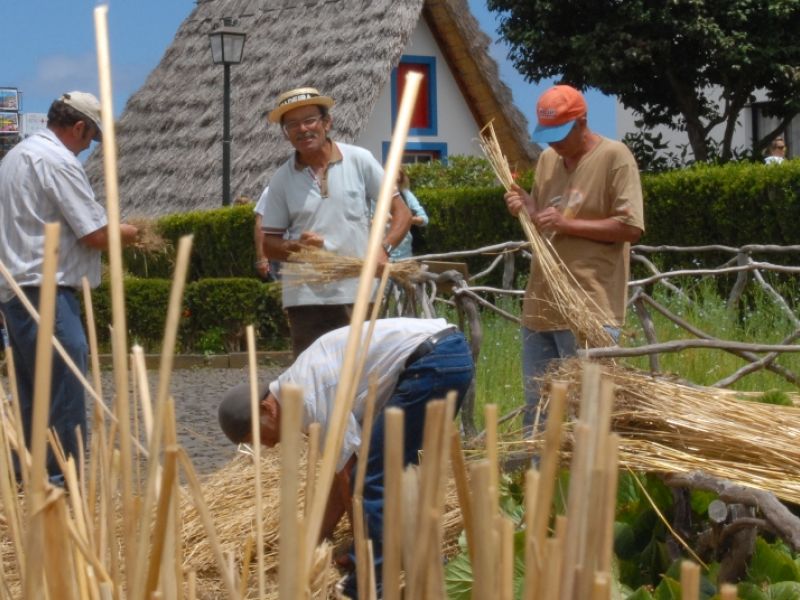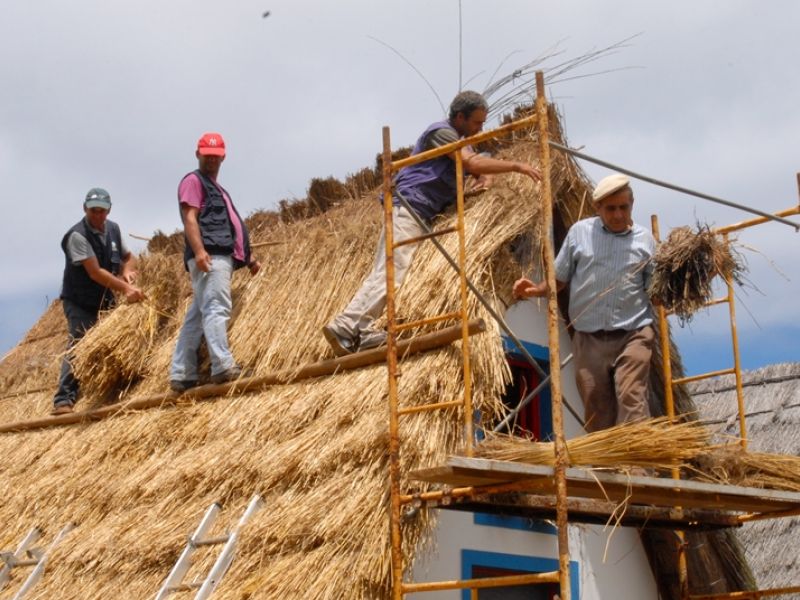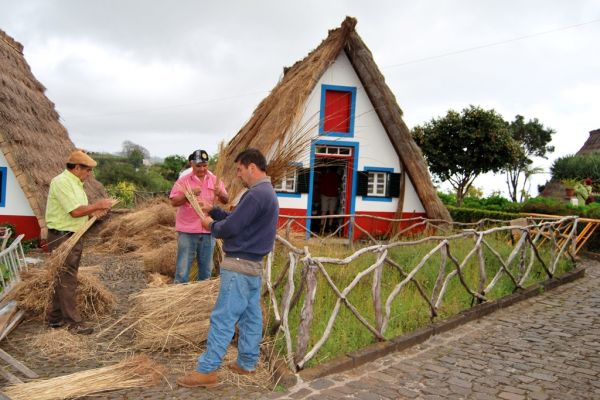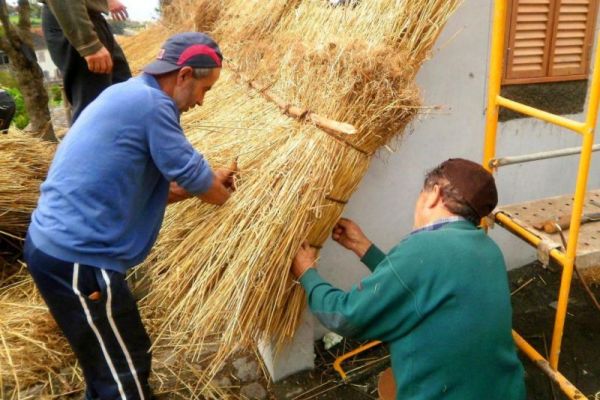The thatched houses of Santana are considered the biggest hallmark of Madeira, as such, its preservation is a priority. In this sense, in public land wheat and rye crops have been made in order to produce the raw material (thatch) required for the bridging of the houses.
This stem is used for the cover of thatched homes both public and private, when requested cooperation by the owners.
All about thatched houses
Building materials:
The “colmo”, either wheat, rye or other variety, is one of the oldest materials used in coverage of housing around the world. In the municipality of Santana, despite having started the use of masonry, roofs thatched were the covers until about 60 years, the preferred option of the population, especially those with weak economic resources. Beyond the thatched roofs other natural materials were used: Wicker, sticks and wood, because they were easy to acquire.
The Colmo
Cereal crops were introduced in Madeira Archipelago during the settlement, probably started in the mid-15th century. Wheat, for their greater versatility, became the most widely produced culture. Some wheat varieties perpetuated over time due to their productive attributes and features typical of culms. Wheat varieties ideal for bridging must present stems silages, linear and robust. His precociousness is also one of the factors that had a lot of influence in the selection. Currently there are regional varieties of wheat sowings "white" and "galhoto".
Sowing takes place normally during the winter season and the harvest of wheat and collecting of the stalks is done in summer season. Stress that the wheat harvest has to be made by hand because the culms should be ripped out without being braked and oriented as parallel as possible.

Wheat field

Wheat harvest
Wickers
Wickers are another natural material which have been used from an early age in manufacturing, especially of furniture, basket ware for being a raw material malleable and with great flexibility.
Its use in the construction of thatched houses has a crucial role, because it serve to tie the sticks that compress the culm base structure, the battens.
As such, Wickers with about 2 m high and 2 cm in diameter are used. Placed to dry, passing by the Smokehouse and when dry should be placed in water for approximately 14 days. All these processes are essential for wickers to stay with sufficient flexibility to the mooring.

Preparation of wicker

Use of wicker in setting sticks
The Sticks
Because they are more resistant and uniform, usually flaky or heather are used across, over and between the various layers of thatch, to contribute to compact coverage

Placement of sticks during bridging
Wood
Initially the wood was used for the entire structure of the thatched house, from the frame to the front. Gradually, the front began to be built with sturdy materials like cement-lined blocks, keeping the wood for the frame.

Wood frame
Dimensions:
Currently, the most common design type in Santana is the home of gable or curbs, because of easier maintenance. But before there were several models of houses covered in “colmo”. We cannot say that all houses have the same dimension, nor the same aspect. There is a template, but when it comes to size, every homeowner built his dwelling according to the land owned and their needs.
In this way, the reference dimensions are:
- Width: 4,64m
- Length: 7m
- Angle: 60º
- Height: 4,4m
Elevation drawings::

Front elevational view

Rear elevational view

Right side elevational

Left side elevational
Plans:

Ground floor plan

Cover plan
Advantages of thatched houses:
<- Lightweight construction and fast execution;
- Excellent ventilation;
- Materials of construction of easy acquisition.
The placement of straw
The traditional form of coverage of the houses consists in placing the “colmo” vertically starting from the bottom up. The “maranhos” are laid out one next to the other overlapping and to ensure isolation.
On the beams sticks are placed horizontally and tied with the wickers, compressing the straw so that it does not drop. This first layer has roughly 15 cm thick and can be made with rye straw, for having a more regular appearance.
At the end of the cover, in the gable the "dolls" are made. These "dolls" have to protect the last "points" that were made with the wickers, so that they do not deteriorate easily.
Completed the coverage, it is necessary to trim the straw, so that it is with a more uniform appearance.
The "roof" presents an average 60-degree slope, which varies depending on the area of the house. The slope is accentuated, in order to ensure the effective draining of rainwaters, preventing their infiltration into the interior. The strong inclination is also a determining factor to guarantee maximum durability of thatched roofs.

Preparation of straw for bridging

Placing first layers of straw

Final layers of bridging
These techniques are delicate and require mastery and practice of experienced men.
Maintenance
The materials used in the construction of thatched Houses are perishable and require regular maintenance. Depending on the quality of the “colmo” and temperatures felt, a partial replacement of thatched roofs that are more spoiled should be made. This replacement can be carried out every 4 or 5 years.

Replacement of thatched roof in a typical house
Replacement of thatched roofs of a typical House rarely carries out a full change of coverage not only because it is more expensive, but also because if the partial changes are efficiently carried out, the thatched interior layer does not deteriorate.
References
- Mestre, Victor, Arquitectura Popular da Madeira, Argumentum, Edições Estudos e Realizações, Lisboa, 2002.
- Ribeiro, João Adriano, Santana – Homens e Assuntos que a Ilustram, Câmara Municipal de Santana, Santana, 2001.
- Ribeiro, João Adriano, Santana – Memórias de uma Freguesia, Junta de Freguesia de Santana, Santana, 2002.



































